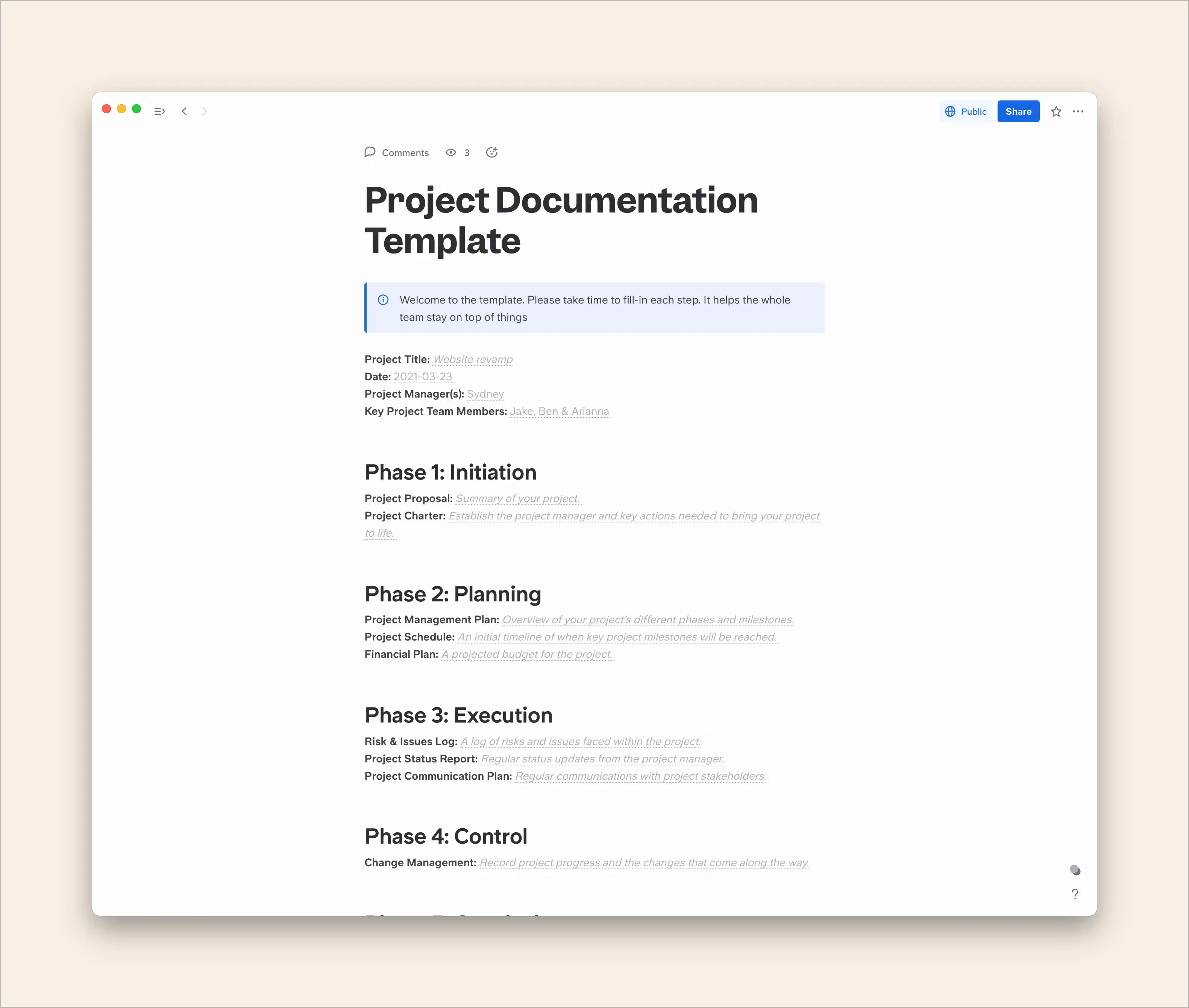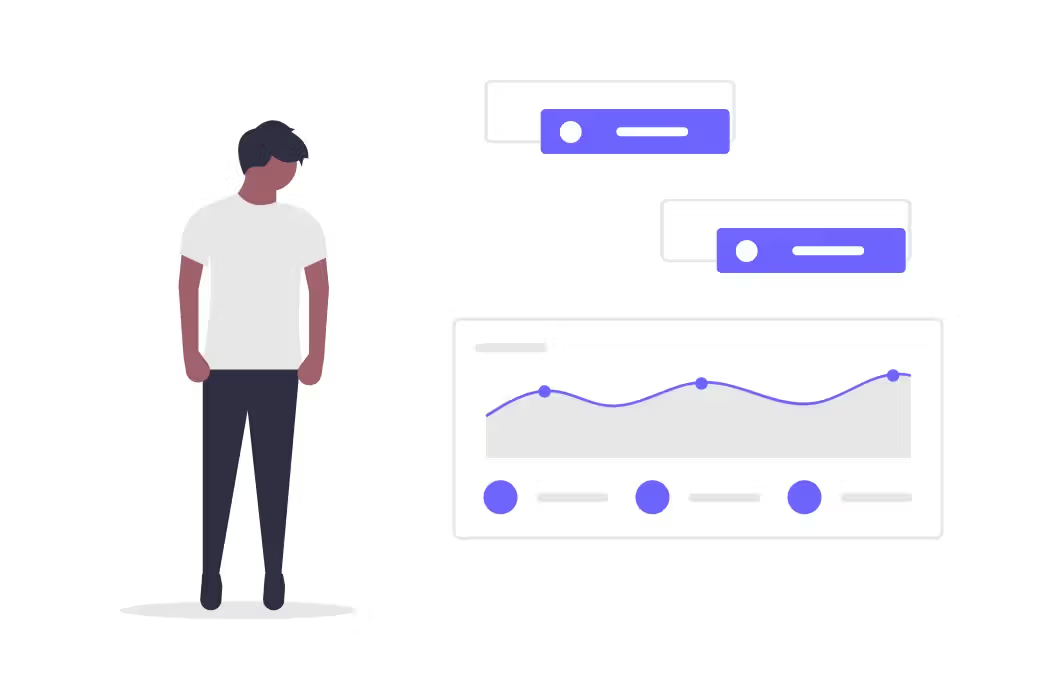What is project documentation?
Project documentation is exactly what it sounds like. At its most basic, it consists of a collection of the essential documents that make up a project. Sounds pretty straightforward, right?
At face value, project documentation is straightforward. However, the sheer volume of paperwork involved in most projects is often daunting to project managers and team members alike. Combine this with poor organization, and you’ve created the perfect storm. Such a project will be difficult to execute and almost impossible to make successful.
That’s where templates come in. A project documentation template reminds you what key project management documents need to be collected, keeps them organized and facilitates easy collaboration. This is why project management teams are increasingly making use of project documentation templates as of the project initiation process.

Who puts together project documentation?
Project documentation is best developed collaboratively. Having said that, project managers have the final say in terms of signing off on it. They are in charge of the project’s management system, process (and process documentation), deliverables, and results, after all.
Owing to this, effective project documentation is normally put together by project managers or other PMPs (project management professionals) and their project teams. This is sometimes done in collaboration with human resources, important stakeholders and other interested parties in relevant project documentation phases as well.
What makes project documentation so important?
The importance of project documentation incorporated into project management tools can’t be underestimated. Don’t make the rookie mistake of shying away from the initial time investment project documentation requires only to end up with more (poorly organized) work on your plate down the road. Veteran project managers sing the praises of project documentation from the rooftops. This is because there are several key ways that using it will help you and your team:
- Keeping Everyone Informed: Project documentation increases transparency and makes sure that all the key people working on a project stay in the loop. This is particularly important in relation to stakeholders who’ll want regular updates in relation to timelines, budget, deliverables and milestones, but it also helps teams work together more effectively. Try out our project budget template here.
- Breaking It Down: When considered in their entirety, projects are incredibly complex. Project documentation allows you and your team to break your project down into key project planning phases represented by key documents and chew them off in bite-sized pieces, so to speak.
- Staying Organized: Effective project documentation helps you keep track of the paperwork you need, and sift through what you don't. Forget about losing track of important documents, especially if you use a well-put-together template.
- Making Collaboration Easy: When your whole project team has access to the same software documentation resources for example, it’s easy to work collaboratively in terms of assigning tasks, working efficiently, tracking process and staying on top of challenges as they come up.
What are the key elements of project documentation?
Project documentation looks a little bit different depending on the industry, company and specific project. However, you can find some variation of the following key elements in the vast majority of project documentation.
We’ll outline each of the key documents below, but they can also be categorized into 5 phases: Initiation, Planning, Execution, Control and Conclusion.

Phase 1: Initiation
The initiation phase is the first phase in a project’s life cycle. This is when a given project is formally approved and brought to life.
Key milestones within Phase 1 include establishing the project manager and project team members, addressing issues of feasibility and justification, determining key project objectives and outlining a project scope statement. These topics are often fleshed out further in Phase 2 as well.
Project Proposal
The project proposal, also known as a business case, is usually the document that kicks off your project development. Keep your project proposal short and sweet. All you need to explain is what your project concept is and what problem it will ultimately address.
Project proposals templates are usually written by the project manager and/or the project sponsor.
Project Charter
The project charter is sometimes referred to as the anchor or blueprint of a project. It’s the first document that’s compiled after your project proposal receives formal approval. Most importantly, it establishes your project team as well as the key actions needed to bring your project to life. It also often covers initial funding allocation and authorization.
Basically, your project charter tells you where you’re starting from. View our Project Charter template here. Alternatively, for bigger projects, you can create a Statement of Work (SoW), which is more detailed than a project charter.
Planning
You’ve secured formal approval for your new project… now what? Well, you’ve entered the second phase of your project’s life cycle. The planning phase! This phase is absolutely critical to a successful project. The more details you collect, the easier the eventual execution of your project will be.
Here, all the different project requirements and actions needed to bring your project to life are outlined as comprehensively as possible, while still keeping things succinct. How’s that for a challenge?
Project Management Plan
With your project management plan, you’re really getting down to the nitty gritty of how your project will come to life. A project management plan can be as short or as long as you want it to be, but it will likely be one of your longest documents.
Basically, you’re asking yourself and your team: “What are all the steps we’ll have to take to successfully complete this project, from beginning to end?”
There are also several documents that are sometimes included within project plans, but can also exist by themselves. These include documents like work breakdown structures (WBS), human resources management plans and quality assurance plans.
All in all, you can usually count on project management plans to address topics like deliverables, time frame, budget, quality and version control, stakeholders and personnel, communication policies and risk management.
Project Schedule
This document is pretty self-explanatory, but it outlines an initial schedule for the deliverables, milestones and phases of your project. Your timeline will likely change throughout your project’s life cycle, but think of this schedule as your starting point.
Pro Tip: Make sure the schedule you establish is realistic. Don’t commit to deadlines that you know your team won’t be able to meet!
Financial Plan
This is another fairly self explanatory document, but it essentially consists of an anticipated budget for your project. It often covers topics like fund procurement and allocation, contracts, financial processes and even projected return on investment (ROI).
Since this document is in the planning phase, it’s usually the initial or projected budget. There’s sometimes another financial document in the execution or control phase in the form of a budget tracker.

Phase 3: Execution
Sometimes referred to as the implementation phase, Phase 3 is when all your planning finally gets put into action. Your team will move from preparation mode to actually putting concrete actions into force.
The execution phase is often the longest phase as it comes with the loftiest goals. Your finished product, whatever that may be, will be formed throughout this phase. How exciting!
Risk & Issues Log
A risk and issues log is a key risk management tool. It consists of a log that helps you keep track of project issues that come up as well as potential future risks on the horizon. The following information is usually included:
- ID number
- Event type (risk or issue, for example)
- Event date
- Description
- Action required
- Owner
- Status
- Priority (optional)
Some risk registers are made with Excel, while others are simple lists.
RAID logs are also sometimes used in place of Risk & Issues Logs. RAID stands for: Risks, Assumptions, Issues & Dependencies.
Project Status Report
Depending on your communication plan, you’ll need to provide regular status reports to various people working on your project. These might consist of stakeholder updates, weekly reviews or department updates.
Whatever the purpose, this section consists of a collection of documents that report on your project’s progress. This is particularly important because it keeps everyone involved on the same page throughout the project’s life cycle. Project status reports can even be used to allocate tasks and next steps.
Project Communication Plan
Similar to project status reports, your project communication plan establishes policies regarding how you and your project team will communicate while working together. Effective communication is vital in project management.
This section differs from project status reports, because instead of establishing project progress, your communication plan lays out exactly how communication will happen. This encompasses specific communication methods, communication frequency and contact information details.
This section often focuses on communication with stakeholders, but it’s important for your project team as well. If your project has an established workflow on Slite, for example, it should be indicated here.
Phase 4: Control
The control phase is sometimes considered to be part of the execution phase, but the two can be separated as well.
The key difference between them is that the execution phase focuses more on putting project processes into action, whereas the control phase focuses on observing those processes and making changes as they come up.
Both phases benefit from good documentation, naturally.
Change Requests & Management
This is the most important section in the control phase of any project and often takes the form of a log. Whenever a change needs to be made to the original project plan, it should be requested and recorded in the change management section.
The following information is usually provided:
- ID number
- Proposed change
- Reason for proposed change
- Timeline
- Owner
Phase 5: Conclusion
At last! We’ve reached the final phase of your project’s life cycle and we’re sure that the result will be a roaring success.
This phase focuses on the closure of your current project, but it also looks towards future projects. Most importantly, you present all deliverables and your finished product. However, this is also a great opportunity to conduct final meetings with your project team and stakeholders, as well as reflect upon what went well during the project and what could be improved upon in the future.
Effective reflection will further streamline your project documentation and management processes and lead to increased success in your future endeavors.
Project Review Document
Also known as a project closure document, a project review document formally concludes your project. Hooray! Just like the project proposal, this document will need review and approval by the project manager, sponsor and relevant stakeholders.
This type of technical documentation normally summarizes what the project accomplished and/or produced, any notable big wins or difficulties and post-project issues or tasks that need to be addressed.

Is there anything else I should include?
As previously mentioned, all project documentation looks a little bit different depending on the industry, company and project context.
The aforementioned elements make up general project documentation essentials, but our list isn’t exhaustive. There are many other kinds of documents that you can integrate depending on your needs, such as a:
- Human Resources Management Plan: This document is sometimes included as part of a project’s management plan. An HR management plan outlines guidelines related to staffing, contracts, training and other HR matters.
- Quality Assurance Plan: Also often included under the scope of a project’s management plan, a quality assurance or QA plan outlines the protocols and processes that will be put in place to ensure the quality of the finished product.
- Test Plan: A master test plan document is normally part of a project’s control phase and determines protocols and processes for how your product will be tested. It’s essentially a blueprint for all product testing that will take place throughout your project’s life cycle and is particularly important in the software and IT industries.
- Lessons Learned Register: A lessons learned register of part of a project’s concluding phase. It serves as an additional project closure document that prompts project managers and their teams to reflect on the successes and drawbacks of their completed project. The purpose of this document is to strive for improved project management in the future!

